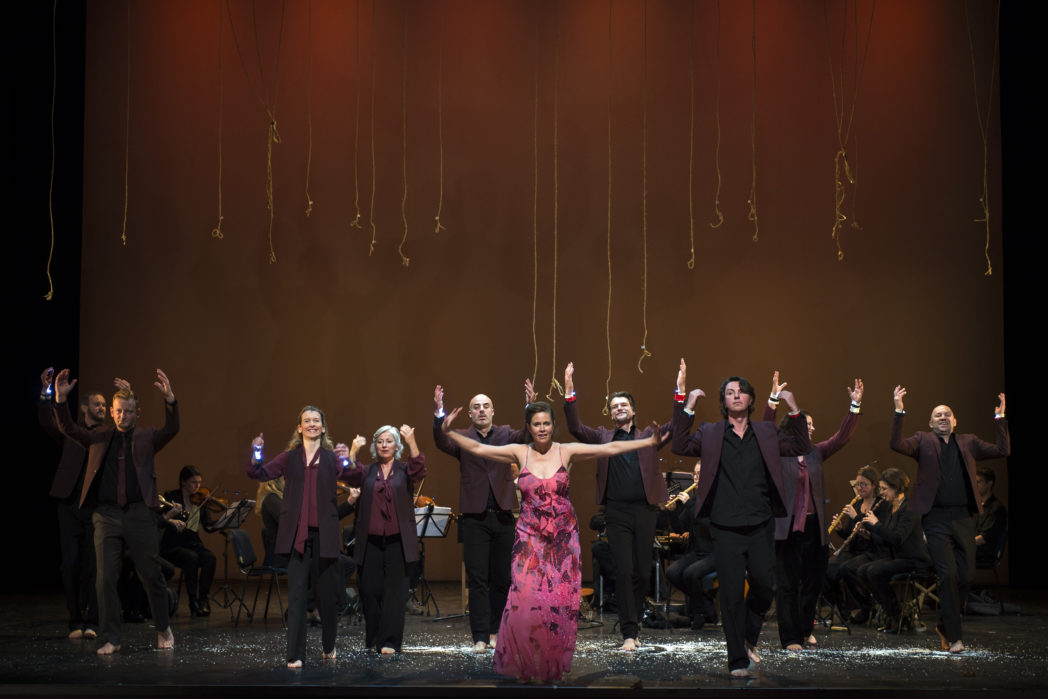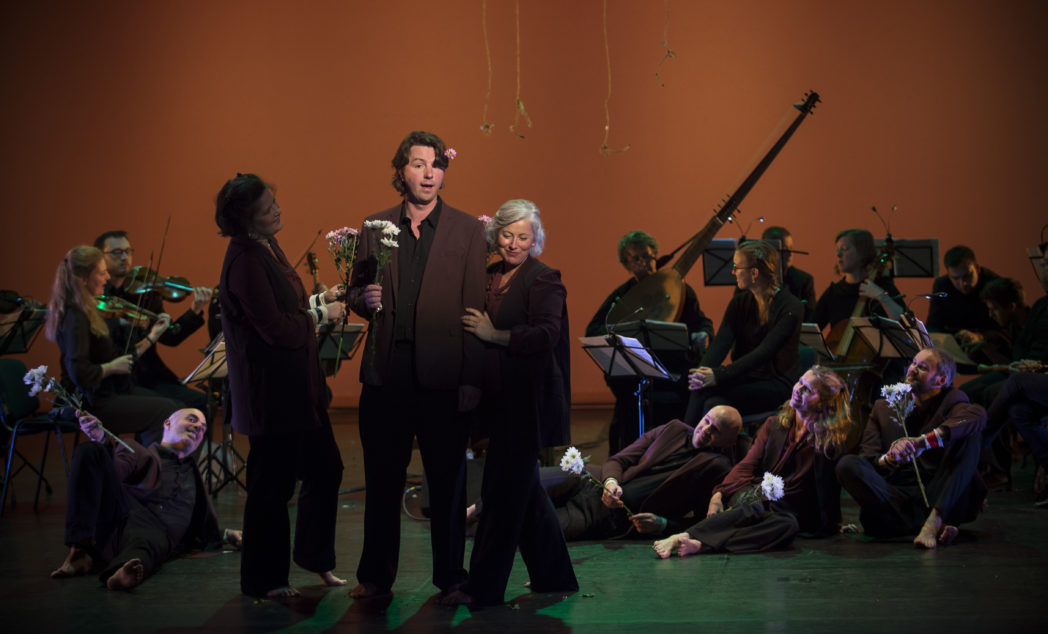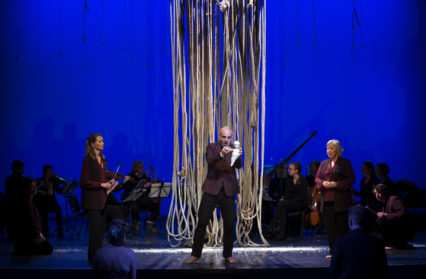Theatr Brecheiniog, Brecon, Friday 21 October 2016
The Fairy Queen – Henry Purcell
Brecon Baroque, leader Rachel Podger
Trinity Baroque
Titania, Sarah Dowling
Oberon, Simon Muller
Musical Director, Julian Podger
Director, Thomas Guthrie
Choreography, Sarah Dowling
Designer, Eleri Lloyd
Lighting designer, Hristo Takov
On the evening of the day on which we had stood in silence to remember the sorrows of Aberfan, we were offered solace by the sweet airs of Henry Purcell in his semi-opera, The Fairy Queen (1692), staged for one night only as the opening event of this year’s Brecon Baroque Festival.
No doubt the theatre in 17th-century England offered audiences temporary relief from the many troubles – not to mention drudgery – of day-to-day life then. The masque scenes of which works like The Fairy Queen were made up were lavish spectacles on a scale which no theatre impresario would contemplate now. So nowadays what do you do – present the music in a concert performance or attempt a staging? The latter is also made difficult by the fact that this is a not a through-composed piece, and the scenes, which were originally intended as entr’actes within Shakespeare’s A Midsummer Night’s Dream (1605), do not form a coherent whole. The risk is that audiences will be hopelessly confused.
So it is to Rachel Podger’s credit that, as artistic director of the Brecon Baroque Festival, she chose to commission a staged performance of this work as part of a celebration of music from the 16th to 18th centuries in London – “Thou Flower of Cities All” as this year’s festival is titled; a quote from a poem by William Dunbar (1465-1520?). Dunbar was a Scottish poet who died more than a hundred years before Purcell was born, but what they have in common was that they were in the employ of the royal court of their time, and – the one in verse, the other in music – variously flattered, entertained and satirised their audiences.

Some scholars believe that The Fairy Queen was written for the fifteenth wedding anniversary of William and Mary; that there are allusions in the work intended in part to repair the strained relationship between the monarchs and their public; and that there is an allegorical relationship between Queen Titania and Queen Mary. If so, such things mean little to modern audiences, and something must be done to update them. In an early production of The Fairy Queen which he directed for English Touring Opera in 2011, Thomas Guthrie set the action in an asylum, referencing the fairy paintings of the Victorian artist Richard Dadd. Nothing as elaborate was possible here, so how was the gap to be bridged between things which interested people in 17th-century London and those which concern an audience in Wales 300 years on?
The direction taken – and perforce it had to be for a production which was for one night only – was to keep things simple and seek primarily to entertain. As the last people were taking their seats in Theatr Brecheiniog, the band, sitting centre stage, struck up the introductory dance tunes: a prelude, hornpipe, aire and rondeau. People continued to chat, as no doubt they would have done in the Dorset Garden Theatre in Blackfriars where the leading actor/manager of the day, and Purcell’s probable librettist, Thomas Betterton, put on the first performance. The band stopped, people politely fell silent and on came someone who appeared to be the house manager – for he was wearing a suit, and a badge! – who expressed delight at the full house, pointed out fire exits and asked people to check that their mobile phones were turned off, before seamlessly turning into a latter-day Oberon, telling us in iambic pentameters that we were there for a celebration of his birthday and to expect, well, the unexpected, and to take it as it came.

At that a trumpet fanfare, answered by another trumpet high in the auditorium, then a recorder duet, lights and singers. The singers – eight members of Trinity Baroque – are (mainly) playing the fairies of the Midsummer’s Night Dream story. One of them, in this telling, is late and drunk. Thomas Guthrie plays the Drunken Poet with convincing stumbles but, apart from this, movement is not the singers’ strong point. Though it is unfair to expect that because, whereas no-one can get into – never mind come out the other side of – drama school unless they can sing and dance, the reverse still does not apply to music colleges. Furthermore a one-off performance comes with a concomitantly short rehearsal period.
The singing, on the other hand, was always stylish, as was the instrumental playing of Brecon Baroque; led with characteristic verve and sensitivity by Rachel Podger on the violin. I particularly enjoyed the stillness and descending cadences of ‘Hush, no more’ with bass-baritone Jakob Bloch Jespersen’s sonorous tones fading to silence as the light cast on the backdrop turned deep blue for the coming of night. There was, overall, a lightness to the singing and playing which never turned to mere frivolity, for all the gentle comedy of the duet between Croydon and Mopsa, in which counter-tenor Miles Lallemant carried off the camp role of Mopsa in a style of his very own!
In this production Titania does not appear until Act II. In the masque, the main characters do not sing, so Sarah Dowling dances Titania’s lament while soprano Rachel Elliott sings, sitting alongside her. The song ‘Oh let me weep’ is reminiscent of Dido’s ‘Lament’ and, sung well as it was here, equally powerful. Singer and dancer had, quite rightly I felt, equal weight in the scene. There was no doubting the passion of the dance, and maybe here was the bridge between the past and the present, singer and players in baroque style, dancer completely contemporary.
While The Fairy Queen is not often staged, there are a number of songs from the production which have an independent life, and it was interesting to hear them in context. Especially notable was soprano Nicki Kennedy’s sparkling rendition of ‘Hark! the echoing air’ while she and Rachel Elliott sang the duet ‘Turn then thine eyes’ with an apparently effortless, pinpoint precision.
Hristo Takov’s lights played to excellent dramatic effect in Act 1 on the massive cat’s cradle/cobweb which designer Eleri Lloyd had drawn down across the stage. Her experience of puppetry while a student of theatre design at the Royal Welsh College of Music and Drama must surely have contributed to the rather bizarre, indeed startling, representation of Hymen the God of Marriage.
This production did not show a way to make sense of The Fairy Queen, but I rather think there is no way to make sense of it! It was, however, certainly worth the effort (considerable for all concerned) to bring it to the stage and showcase what is at its heart: Purcell’s glorious music.
Header photo credit Angus Taylor



 Enjoyed this article? Support our writers directly by buying them a coffee and clicking this link.
Enjoyed this article? Support our writers directly by buying them a coffee and clicking this link.







